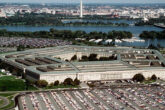April 08, 2019
Transcript: How the U.S. Military Fights Wars Today and In the Future
CENTER FOR A NEW AMERICAN SECURITY DEFENSE PROGRAM
“HOW THE U.S. MILITARY FIGHTS WARS TODAY AND IN THE FUTURE”
March, 07, 2019 – 08:18 a.m. ET
PANEL MEMBERS
SUSANNA BLUME, CNAS DEFENSE PROGRAM DEPUTY DIRECTOR
DAVID OCHMANEK, RAND CORPORATION SENIOR INTERNATIONAL DEFENSE RESEARCHER
CHRIS DOUGHERTY, CNAS DEFENSE PROGRAM SENIOR FELLOW
ROBERT O. WORK, CNAS DISTINGUISHED SENIOR COUNSELOR FOR DEFENSE
BLUME: Hi, everybody. Thank you so much for coming today. My name is Susanna Blume. I’m senior fellow and deputy director of the defense program here at CNAS. And we are gathered here today to talk about how the U.S. military fights wars today, but more importantly, in the future.
And I hope that you will indulge me in a slightly longer-than-usual preamble here, because I think it’s important for us all to know what--what it is that we’re talking about and, particularly, why these three gentlemen to my left are here to talk about it.
And so, we start, as I almost always do, at these events with the National Defense Strategy. It clearly defined the Pentagon’s top priority as competition and potential conflict with China and Russia. And effectively, with the NDS, it was change the ends of--of U.S. defense strategy. And it also implied that the Department of Defense would also have to change the ways it approaches these new ends.
But, to date, much of the discussion about the NDS is actually focused on the means. It’s focused on how much money is in the Defense budget. Are we buying X instead of Y? What do we need to shift? What do we need to move? And as--as you all know, this is actually what I spend most of my time talking about. It’s a very important and worthy topic, but--but--we’ve--we’ve, to date, kind of missed this discussion about the ways, about that step two in the ends, ways, means paradigm.
And so, CNAS and, specifically, our new--newest Senior Fellow in the Defense program, Chris Dougherty, is launching a project to address this shortcoming, and it’s called “A New American Way of War.” We like to call it ANAWOW for short, ‘cause you’ve gotta have a zippy acronym, right?
And his hypo--his hypothesis is basically that the shift in strategy is profound enough that we have to fundamentally rethink the--the way that we fight and that this thinking about the way that we fight should also inform what we buy and how much is enough. So, that’s the thesis of the project.
And joining me here today, to said--shed some light on this subject, and to launch this new project that we’re undertaking here, are really the two dons of American force planning. And Bob Work and Dave Ochmanek--I knew you were gonna hate that, so I didn’t tell you about it in advance-- And--and Chris, himself, who is one of the foremost next-generation thinkers in this space.
So, Chris, as I mentioned, is a senior fellow here, and he’s the mastermind of this new American Way of War project. Prior to coming to CNAS, he worked in the Office of Strategy and Force Development in the Pentagon and was a key drafter of the 2018 National Defense Strategy. What we like to say is that he wrote the pointy bits, which is rough on characterization of his role of that process.
During his time in the Pentagon, before and previously at the Center for Strategic and Budgetary Assessments, Chris also assessed the ability of the military to meet its strategic ambitions and worked on new operational concepts designed to meet the demands of deterring China and Russia.
Bob, who, as many of you know, is a senior counselor and distinguished senior fellow also here at CNAS. Prior to--to that role, he served as the Deputy Secretary of Defense, where his work leading the Third Offset was, in many ways, an important lead and precursor to what eventually become the NDS. It was a very influential bit of strategy and planning.
But, beyond the formal titles, you know, Bob was a preeminent visionary in--in the U.S. Defense Strategy and force-planning space, beginning in his time in the Office of Net Assessment and through tenures at CSBA, and then previously here, as the CEO of CNAS, you know, he’s consistently been looking, you know, 20 years and beyond into the future, diagnosing critical military competitions and coming up with innovative concepts and strategies for meeting those.
Dave is a senior international and defense researcher at the RAND Corporation. He has interspersed his time at RAND with two stints as a deputy assistant secretary of defense. First, as the DASE for Strategy, 1993 to 1995, and then again as the DASE for Force Development from 2009 to 2014. And in those roles, he played a really critical role in shaping U.S.--post-Cold War U.S. defense strategy, particularly emphasizing the size, the shape, the readiness of the joint force.
But, again, you know, more important than those infi--official titles, is that Dave is a preeminent analyst--I’m going to flatter you some more, just get ready-- --(LAUGHTER)-- --but, preeminent analyst of force planning in the U.S., and his ideas and methods have influenced, really, every major strategy review or shift in the--in the size and shape--the composition of the joint force since the end of the Cold War, up to and including the National Defense Strategy.
So, that’s who these three gust--guests here with me today are. And--and that’s why we selected these specific panelists to come and talk about this topic. And so, without further ado, I’m gonna dive right in. I’m gonna give the first question to Chris, and I’m gonna ask him to define some terms for us.
So, what is a way of war? You know, how is it different from official doctrine or operational concepts? Why does it matter?
DOUGHERTY: Absolutely. That’s a great question. There’s been a lot of writing on the American way of war in particular, and I think each--each scholar who’s delved into that question has defined it slightly differently. You know, Russell Weigley kind of originated the term, had his own--had his own definition. I know Antulio Echeverria, who, I believe, (INAUDIBLE) here, defined it as an American way of battle. There’ve been different kinds of ways of thinking about it.
The way I see it and the way this project is going to approach it is as a common set of assumptions and expectations about how war unfolds and what war looks like. And--and Carl Builder, in his book--his kind of masteral book, Masks of War, called it the--the Image of Conflict. It’s--if you close your mind--if you close your eyes, and in your mind’s eye, you see how a war unfolds, that narrative structure about how it--what it looks like and how it unfolds informs the way you plan operationally.
And this manifests itself, I think, in the joint force and--and in our--our military thinkers in the template that we approach military problems with. And--and that template--you can see it, I think, most clearly if you do a lot of war gaming. You sit a joint planner down or a service planner down in front of--of a--a war gamer or any kind of operational problem and, generally speaking, the solution is within a--a 90 percent the--the same, every single time.
And that template that they’re bringing with them, that is the way of war that we bring with us. And it is--informs doctrine, it informs our concepts, but it’s a little bit more soaked into the marrow of our thinking than--than official writing.
BLUME: Yeah. Bob or Dave, do you have anything to add?
OCHMANEK: No, I think that’s good.
BLUME: All right.
WORK: I was just say that I view--I don't think the American way of war, or a way of war, is a static thing. I address it primarily through strategic culture, which is an imprecise term, but it’s based on the geography of the power, the ingrained experience.
So, the United States--the ingrained experience is transoceanic power projection or counterpower projection. That’s it. That is our ingrained experience. So, everything we do--we fight an away game, we have to get across to broad oceans to do it.
The third thing is the overarching military regime, which changes. What is the way of war across all of the competitors? And who are the strategic competitors? And finally, strategic culture--you can see the value of human capital and technology. And the interplay of the two has a major, major impact on the way you think about how you would fight a war.
BLUME: Okay. Bob, I think I’ll stick with you for this next question here. What is the current American way of war? And how did it come about?
More from CNAS
-
The Department of Defense’s Breakthrough Nuclear Moment Risks Slipping Away
Unless they act, the Department of Defense’s breakthrough nuclear moment may vanish before it really happens....
By Will Rogers
-
DEFAERO Strategy Series [Apr 09, 25] CNAS' Becca Wasser and Phil Sheers on Revitalizing the U.S. Defense Industrial Base
On this episode of the Defense & Aerospace Report Strategy Series, sponsored by General Atomics Aeronautical Systems, Becca Wasser and Phil Sheers of the Center for a New Amer...
By Becca Wasser & Philip Sheers
-
From Production Lines to Front Lines
Executive Summary The U.S. defense industrial base (DIB) is struggling to meet the demands of the current strategic environment—let alone prepare for a potential conflict agai...
By Becca Wasser & Philip Sheers
-
The Pentagon’s Endangered Brain Trust
In this environment, sound assessments of emerging threats and new ideas to counter them will be especially vital....
By Dr. Andrew Krepinevich, Jr.




